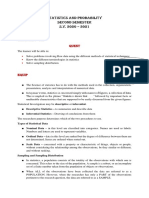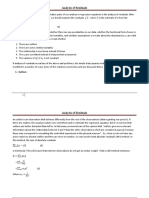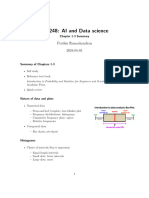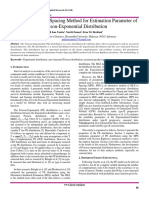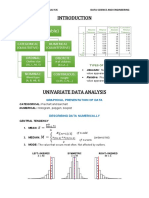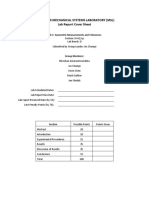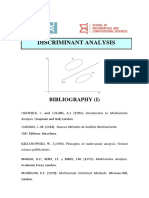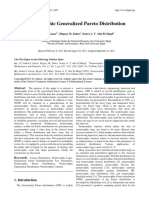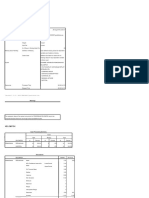Professional Documents
Culture Documents
Probability of Misclassification Under Nelly Distribution Using Optimal Rule
Copyright
Available Formats
Share this document
Did you find this document useful?
Is this content inappropriate?
Report this DocumentCopyright:
Available Formats
Probability of Misclassification Under Nelly Distribution Using Optimal Rule
Copyright:
Available Formats
Volume 8, Issue 5, May – 2023 International Journal of Innovative Science and Research Technology
ISSN No:-2456-2165
Probability of Misclassification Under Nelly
Distribution Using Optimal Rule
Nnabude Chinelo Ijeoma1
S. I. Onyeagu (Professor)2
Dr. C. H. Nwankwo3
Department of Statistics, Faculty of Physical Sciences, Nnamdi Azikiwe University,
Awka, Anambra State, Nigeria
Abstract:- Errors of misclassification and their (2𝜆𝑖 )∝ 𝑋 ∝−1 𝑒 −2𝜆𝑖𝑥
probabilities are studied for classification problems 𝑓𝑖 (𝑋) = 𝑖 = 1,2 (1)
Г(∝)
associated with univariate Nelly distribution. The effect
of applying the linear discriminant function (LDF) based The Robustness of the Linear Discriminant Function
on normality to Nelly populations are assessed by will be Examined in two ways
comparing probability (Optimum) based on the linear
discriminant function (LDF) with those based on the Supposing that in classifying an observation X from (1),
likelihood ratio rule (LR) for the Nelly. Both theoretical the linear discriminant function (LDF) derived under
and empirical results are presented. the assumption of normality, how are the optimum
(based on all parameters being known) probability of
Keywords:- Errors of Misclassification, Nelly Distribution, misclassification affected?
Linear Discriminant Function, Likelihood Ratio Rate, Error The optimum probability of misclassification based on
Rate. the likelihood ratio rule will be compared with those
obtained from linear discriminant function.
I. INTRODUCTION
II. THE CLASSIFICATION RULES
The linear discriminant function (LDF) when used to
categorize an observation that belongs to one of two normal A classification rule or classifier is a process by which
population, has numerous advantageous qualities in the elements of the population set are each expected to
classification issues. The parent populations’ multivariate belong to one of the classes given a population whose
normal distributions are assured in the majority of the study. members each belong to one of a number of different sets or
In the univariate case (denoted by 𝑁(𝜇, 𝜎 2 )), the classes. Every component of the population is assigned to
classification problem has been studied by John [6] and the class which it actually belongs in a flawless
Sedransk and Okamoto [10]. Numerous kinds of non- categorization. If certain flaws are present in the
normality have t heir effects studied. The linear discriminant classification, statistical analysis must be used to examine
function’s resilience when the underlining distribution is a the classification. The general solution to the classification
part of Johnson’s system was investigated by Lachenbruch rule is to minimize the total probability of misclassification.
et. al (1975). Further exploring this issue, Ching’anda [4], (Anderson, 1958)
Ching’anda and Subrohmaniam [5] developed distributions
based on sizable samples for both conditional and Suppose that 𝑓𝑖 (𝑥) is the density function of 𝑋 if it
unconditional probabilities of misclassification. Similar comes from the population
studies have been done for the inverse Gaussian distribution
by Amoh and Kocherlakota [2] and Gamma distribution by Πi (𝑖 = 1,2) and we assign 𝑋 to Π1 if 𝑋 is in some
Mahmoud and Moustafa [9].
region 𝑅1 and to Π2 if 𝑋 is in some region 𝑅2.
In this paper, we will consider the probability of
We assume 𝑅1 ∩ 𝑅2 = ∅, 𝑅1 ∪ 𝑅2 = 𝑅
misclassification using optimal rule, when we have two
Let 𝑃𝑖 (𝑖 = 1, 2) be the proportion (Bayes assumption)
classes and sampling from Nelly distributions. The
of population Π1. 𝑃1 + 𝑃2 = 1. The total probability of
probability of misclassification distributions is examined.
misclassification is
The parameters 𝑋1 and 𝑋2 are known coming from Nelly
distributions.
𝐸 = 𝑃1 ∫ 𝑓1 (𝑥) 𝑑𝑥 + 𝑃2 ∫ 𝑓2 (𝑥) 𝑑𝑥
𝑅2 𝑅1
IJISRT23MAY669 www.ijisrt.com 1456
Volume 8, Issue 5, May – 2023 International Journal of Innovative Science and Research Technology
ISSN No:-2456-2165
𝐸 = 𝑃1 [1 − ∫ 𝑓1 (𝑥) 𝑑𝑥 + 𝑃2 ∫ 𝑓2 (𝑥) 𝑑𝑥 ]
𝑅1 𝑅1
= 𝑃1 − [𝑃1 ∫ 𝑓1 (𝑥) + 𝑃2 ∫ 𝑓2 (𝑥) 𝑑𝑥]
𝑅1 𝑅1
𝐸 = 𝑃1 + ∫𝑅 [𝑃2 𝑓2 (𝑥) − 𝑃1 𝑓1 (𝑥)] 𝑑𝑥 (2)
1
Where 𝐸 is minimized (Neyman Pearson Lemma) if 𝑅1 included the points 𝑋 such that [𝑃2 𝑓2 − 𝑃1 𝑓1 ] < 0 and excludes the
points for which [𝑃2 𝑓2 − 𝑃1 𝑓1 ] > 0. Thus, the classification rule is
𝑓1 𝑃2
𝑅1 ∶ ≥
𝑓2 𝑃1
𝑓1 𝑃2
𝑅2 ∶ <
𝑓2 𝑃1
1
In what follows, assume 𝑃1 = 𝑃2 = 2 , it is well known that if 𝑃1 = 𝑃2 and 𝑓𝑖 (𝑥) is univariate normal; the classification
rule given above is equivalent to Fisher’s Linear Discriminant function. (Lachenbruch, 1975).
Linear Discriminant Function for the Univariate Normal Distribution
(known 𝜇1 ≠ 𝜇2, and the same Variance 𝜎 2)
let the probability density function of 𝑋 in 𝜋𝑖 (𝑖 = 1, 2) be
1 1 𝑋 − 𝜇𝑖 2
𝑓𝑖 (𝑥) = 𝑒𝑥𝑝 [− ( ) ] − ∞ < 𝑥 < ∞, 𝑖 = 1,2
𝜎√2𝜋 2 𝜎
If 𝜃 is the mean of the observation X and
𝐻0 ∶ 𝜃 = 𝜇1 vs
𝐻𝑎 : 𝜃 ≠ 𝜇2
Then the likelihood when 𝜇1 < 𝜇2
𝑓1 (𝑥) 1 𝑋 − 𝜇1 2 1 𝑋 − 𝜇2 2
𝐿= = 𝑒𝑥𝑝 [− ( ) + ( ) ]
𝑓2 (𝑥) 2 𝜎 2 𝜎
−1 𝑋 − 𝜇1 2 1 𝑋 − 𝜇2 2
𝐿′ = ( ) + ( )
2 𝜎 2 𝜎
−1
= [2𝑋 − (𝜇1 + 𝜇2 )](𝜇2 − 𝜇1 )
2𝜎 2
1 𝜇1 − 𝜇2
= [𝑋 − (𝜇1 + 𝜇2 )] ( ) (3)
2 𝜎
The above equation is the Anderson discriminant function, when the distributions in the populations are univariate normal
with the same variance but different means. 𝐻𝑜 is rejected 𝑖𝑓 𝐿 < 𝐾, where K is a constant from equation 3.
The classification rule specifies as
1
Classify 𝑋 ∈ 𝜋1 𝑖𝑓 𝑋 < 2 (𝜇1 + 𝜇2 ) and
1
Classify 𝑋 ∈ 𝜋2 𝑖𝑓 𝑋 ≥ (𝜇1 + 𝜇2 )
2
IJISRT23MAY669 www.ijisrt.com 1457
Volume 8, Issue 5, May – 2023 International Journal of Innovative Science and Research Technology
ISSN No:-2456-2165
Similarly, when 𝜇1 > 𝜇2 the classification rule becomes
1
Classify 𝑋 ∈ 𝜋2 𝑖𝑓 𝑋 < 2 (𝜇1 + 𝜇2 ) and
1
Classify 𝑋 ∈ 𝜋1 𝑖𝑓 𝑋 ≥ (𝜇1 + 𝜇2 )
2
Derivation of Classification Rule for Nelly Distribution
We assume that the distributions of X in 𝜋𝑖 is given by Nelly distribution. Then the classification rule for Nelly distribution
is
(2𝜆𝑖 )∝ 𝑋 ∝−1 𝑒 −2𝜆𝑖𝑥
𝑓𝑖 (𝑋) =
Г(∝)
(2𝜆1 )∝ 𝑋∝−1 𝑒−2𝜆1𝑥
𝑓1 (𝑋) Г(∝)
𝐿= 𝑓 (𝑋)
= (2𝜆2 )∝ 𝑋∝−1 𝑒−2𝜆2𝑥
(4)
2
Г(∝)
𝜆 ∝
= ( 1) 𝑒 2(𝜆2− 𝜆1)𝑥 (5)
𝜆2
𝑓1
Since 𝐼𝑛 ≤ 𝐼𝑛𝑘
𝑓2
𝜆1
2(𝜆2 − 𝜆1 )𝑥 ≤ 𝐼𝑛 𝑘− ∝ 𝐼𝑛 ( )
𝜆2
1 𝜆1
𝑋 ≤ [𝐼𝑛 𝑘− ∝ 𝐼𝑛 ( )]
2(𝜆2 − 𝜆1 ) 𝜆2
𝐼𝑛 𝑘 𝛼 𝜆
≤ 2(𝜆2 − 𝜆1 )
- 2(𝜆 𝐼𝑛 (𝜆1)
2 − 𝜆1 ) 2
The classification rule would be
𝑅1 = {𝑋 ; 𝑥 ≥ 𝐵 𝑖𝑓 𝜇1 ≥ 𝜇2 }
𝛼 𝜆
Where 𝐵 𝑖𝑠 = 𝐼𝑛 (𝜆1)
2(𝜆2 − 𝜆1 ) 2
The optimum probabilities of misclassification of Nelly distribution using Linear discriminant function (LDF) and
Likelihood ratio (LR)
For LDF we have
𝐸12 = 𝑃 {𝑋 < 𝐴 / 𝑋 ∈ 𝜋1 ; 𝜇1 , 𝜇2 } 𝑖𝑓 𝜇1 > 𝜇2 and 𝐸21 (𝜇1, 𝜇2) similarly defined.
𝛼
The cumulative distribution function of Nelly distribution with parameters 𝜇1 and 𝛼 (𝜇𝑖 = ) is given by
2𝜆
𝛶(∝, 𝜇𝑥)
𝐹(𝑥, ∝, 𝜇) = = 𝑃(∝, 𝜇𝑥) (6)
Г(∝)
(−1)𝑛 (𝜇𝑥)∝+𝑛
Where 𝛶(∝, 𝜇𝑥) = ∑∞
𝑛=0 𝑛!(∝ +𝑛)
Then using equation 1 we have
(𝜇1 + 𝜇2 )
𝐸12 = 𝐹(𝐴: ∝, 𝜇1 ), 𝜇1 > 𝜇2 : 𝐴 =
2
Therefore, the total optimum probability of misclassification using LDF is given as
IJISRT23MAY669 www.ijisrt.com 1458
Volume 8, Issue 5, May – 2023 International Journal of Innovative Science and Research Technology
ISSN No:-2456-2165
(𝐸12 + 𝐸21 )
𝐸= 2
𝑓𝑜𝑟 𝑃1 = 𝑃2 = 0.5 (7)
For Likelihood Ratio
∗
𝐸12 = 𝑃{𝑋 < 𝐵 ǀ 𝑋 ∈ 𝜋1 } = 𝐹(𝐵, ∝, 𝜇), 𝑖𝑓 𝜇1 > 𝜇2
𝛼 𝜆
Recall B = 𝐼𝑛 ( 1)
2(𝜆2 − 𝜆1 ) 𝜆2
Therefore, the total probability of misclassification using LR is given as
∗ + 𝐸∗ )
(𝐸12
𝐸∗ = 2
21
𝑓𝑜𝑟 𝑃1 = 𝑃2 = 0.5 (8)
Therefore, the probabilities of misclassification based on the linear discriminant function (LDF) and likelihood ratio (LR )
rules for various combination of the parameter 𝜆1 , 𝜆2 𝑎𝑛𝑑 ∝ the values chosen are 𝜆1 = 1.0, 𝜆2 = 2.0, 3.0, 4.0 𝑎𝑛𝑑 ∝ =
2.0, 3.0, 4.0, 5.0,…, 15.0
III. RESULTS
Table 1 Comparison of the optimum probability of misclassification based on the LDF and LR when 𝜆1=1 and 𝜆2=2
Parameters Linear Discriminant Function (LDF) Likelihood Ratio (LR)
𝜆1 𝜆2 𝛼 𝐸12 𝐸21 𝐸 𝐸12 ∗ 𝐸21 ∗ 𝐸∗
1 2 2 0.1734 0.0549 0.1142 0.1398 0.0431 0.0914
3 0.4789 0.1078 0.2934 0.3674 0.0771 0.2223
4 0.1156 0.0075 0.0095 0.0830 0.0556 0.0693
5 0.0115 0.0087 0.0101 0.1708 0.1314 0.1511
6 0.0072 0.0052 0.0062 0.1981 0.1474 0.1727
7 0.0059 0.0055 0.0057 0.3880 0.3605 0.3743
8 0.0053 0.0037 0.0045 0.5117 0.3650 0.4382
9 0.0010 0.0007 0.0009 0.2141 0.1572 0.1856
10 0.0005 0.0006 0.0005 0.3322 0.3431 0.3376
11 0.0004 0.0003 0.0004 0.4437 0.3603 0.4020
12 0.00001 0.00004 0.00001 0.1039 0.0282 0.0661
13 0.00001 0.000002 0.000006 0.1171 0.0303 0.0737
14 0.000005 0.000001 0.000003 0.1210 0.0279 0.0745
15 0.0000003 0.0000006 0.0000001 0.1113 0.0212 0.0663
Table 1 gives a comparison between the linear discriminant function of Nelly distribution and likelihood ratio of Nelly
distribution when all the parameters are known; that is (𝜆1 =1, 𝜆2=2 and α =2 to 15)
Table 2 Comparison of the Optimum Probability of Misclassification based on the LDF and LR when 𝜆1=1 and 𝜆2=3
Parameters Linear Discriminant Function (LDF) Likelihood Ratio (LR)
𝜆1 𝜆2 𝛼 𝐸12 𝐸21 𝐸 𝐸12 ∗ 𝐸21 ∗ 𝐸∗
1 3 2 0.1443 0.0213 0.0828 0.0370 0.0047 0.0209
3 0.3823 0.0288 0.2055 0.0626 0.0032 0.0329
4 0.0093 0.0005 0.0049 0.2030 0.0047 0.1041
5 0.0029 0.0010 0.0019 0.0228 0.0084 0.0156
6 0.0022 0.0011 0.0017 0.0484 0.0256 0.0370
7 0.0018 0.0009 0.0014 0.0759 0.0412 0.0585
8 0.0009 0.0006 0.0007 0.1000 0.0699 0.0850
9 0.0008 0.0005 0.0007 0.1702 0.1134 0.1418
10 0.0007 0.0006 0.0007 0.3588 0.3036 0.3312
11 0.0004 0.0003 0.0004 0.3955 0.3245 0.3599
12 0.0003 0.0002 0.0003 0.5845 0.4462 0.5154
13 0.0002 0.0001 0.0002 0.6956 0.5181 0.6069
14 0.000001 0.000001 0.000001 0.9051 0.6947 0.7999
15 0.000001 0.0000006 0.000001 0.000004 0.000006 0.000003
IJISRT23MAY669 www.ijisrt.com 1459
Volume 8, Issue 5, May – 2023 International Journal of Innovative Science and Research Technology
ISSN No:-2456-2165
Table 2 gives a comparison between the linear discriminant function of Nelly distribution and likelihood ratio of Nelly
distribution when all the parameters are known; that is (𝜆1 =1, 𝜆2=3 and α =2 to 15)
Table 3 Comparison of the Optimum Probability of Misclassification based on the LDF and LR when 𝜆1=1 and 𝜆2=4
parameters Linear discriminant function (LDF) Likelihood ratio (LR)
𝜆1 𝜆2 𝛼 𝐸12 𝐸21 𝐸 𝐸12 ∗ 𝐸21 ∗ 𝐸∗
1 4 2 0.0161 0.0071 0.0116 0.0237 0.0105 0.0171
3 0.3360 0.0111 0.1736 0.0106 0.0002 0.0054
4 0.0034 0.0010 0.0022 0.0123 0.0039 0.0081
5 0.0053 0.0013 0.0033 0.0262 0.0065 0.0164
6 0.0040 0.0008 0.0024 0.0326 0.0071 0.0199
7 0.0013 0.0003 0.0008 0.0260 0.0069 0.0165
8 0.0007 0.0002 0.0005 0.0383 0.0136 0.0259
9 0.0006 0.0002 0.0004 0.0711 0.0268 0.0489
10 0.0006 0.0004 0.0005 0.2196 0.1469 0.1833
11 0.0004 0.0001 0.0003 0.1660 0.0664 0.1162
12 0.0003 0.0002 0.0002 0.3967 0.2600 0.3283
13 0.0002 0.0001 0.0002 0.6532 0.5239 0.5886
14 0.000001 0.000006 0.000008 0.6103 0.4085 0.5094
15 0.0000002 0.0000005 0.0000001 0.0000003 0.0000008 0.0000006
Table 3 gives a comparison between the linear discriminant function of Nelly distribution and likelihood ratio of Nelly
distribution when all the parameters are known; that is (𝜆1 =1, 𝜆2=4 and α =2 to 15)
IV. CONCLUSION [9]. Mahmoud and Moustafa (1995). Estimation of a
discriminant function from a mixture of two gamma
Based on the result of the analysis of data, it can be distributions when sample size is small, Mathl.
concluded that the likelihood ratio of the Nelly distribution Comput. Modelling 18 (5), 87-95 (1993).
performs better than its linear discriminant function [10]. Sedransk, N and Okamoto, M. (1971). Estimation of
the probability of misclassification for a linear
REFERENCES discriminant function in the univariate normal case.
Annals of the institute of statistical mathematics 23,
[1]. Abramowitz, M. and Stegun, I. A. (1970) Editors, 419 - 43
Handbook of Mathematical Functions, Dover, New
York, .
[2]. Amoh, R.K. and Kocherlakota, K. (1986). Errors of
misclassification associated with the inverse
Gaussian distribution. Communications in Statistics,
theory and methods, 15(2), pp.589-612.
doi:10.1080/03610928608829139
[3]. Anderson, T. W. (1958). An introduction to
multivariate statistical analysis. 1st edition. John
Wiley and sons, inc., New York.
[4]. Ching’anda E. F. and Subrahmaniam, K. (1976).
Misclassification errors and their distribution:
Robustness, M.Sc thesis, University of Manitoba
[5]. Ching’anda E. F. and Subrahmaniam, K. (1979).
Robustness of the linear discriminant function to non-
normality: Johnson’s system, J. statist. Planning and
inference 3, 69 – 77
[6]. John, S. (1961). Errors in discrimination. The annals
of mathematical statistics vol. 32, No 4, pp. 1125 –
1144. https://www.jstor.org/stable/2237911
[7]. Lachenbruch, P. A., Sneeringer C. and Reve L. T.
(1973). Robustness of the linear and Quadratic
discriminant function to certain types of non-
normality, Commun. Statist. 1, 39 – 57 (1973)
[8]. Lachenbruch, P. A. (1975). Discriminant analysis. 1st
edition Hafner press, New York
IJISRT23MAY669 www.ijisrt.com 1460
You might also like
- CS263 - Bayesian Decision TheoryDocument16 pagesCS263 - Bayesian Decision TheoryAaron Carl FernandezNo ratings yet
- Probability and StatisticsDocument53 pagesProbability and Statisticsvinita sandriNo ratings yet
- Module02 ANOVADocument28 pagesModule02 ANOVAasdfNo ratings yet
- Lecture # 3 (Heteroskedasticity in Cross-Sectional Data)Document5 pagesLecture # 3 (Heteroskedasticity in Cross-Sectional Data)Batool SahabnNo ratings yet
- Lecture 3-MSDA 3055Document44 pagesLecture 3-MSDA 3055dhaval galaNo ratings yet
- Research Article: Bootstrapping Nonparametric Prediction Intervals For Conditional Value-at-Risk With HeteroscedasticityDocument7 pagesResearch Article: Bootstrapping Nonparametric Prediction Intervals For Conditional Value-at-Risk With HeteroscedasticityAyudikta Fitri SalaamNo ratings yet
- Quality MidsemDocument179 pagesQuality MidsemHEMANTH KAJULURINo ratings yet
- Kernel Embeddings of Conditional DistributionsDocument33 pagesKernel Embeddings of Conditional DistributionsDaniel VelezNo ratings yet
- Applied Statistics II-SLRDocument23 pagesApplied Statistics II-SLRMagnifico FangaWoro100% (1)
- Statistics and Probability Second SEMESTER S.Y. 2020 - 2021: QuestDocument5 pagesStatistics and Probability Second SEMESTER S.Y. 2020 - 2021: QuestTessia EralithNo ratings yet
- Scoring MethodsDocument8 pagesScoring MethodsMayur JoshiNo ratings yet
- CH 4Document14 pagesCH 4Beke derejeNo ratings yet
- Pres05 MNG512 (111 - 112) Sensitivity To Parameter VariationsDocument13 pagesPres05 MNG512 (111 - 112) Sensitivity To Parameter VariationsMahmudul HasanNo ratings yet
- SDET Formulae MidSem2 2018 Ver3Document2 pagesSDET Formulae MidSem2 2018 Ver3Ritvick GuptaNo ratings yet
- 統計摘要Document12 pages統計摘要harrison61704No ratings yet
- CQE Academy Equation Cheat Sheet - DDocument15 pagesCQE Academy Equation Cheat Sheet - DAmr AlShenawyNo ratings yet
- 8.6.2 An Analysis On The Location and Type of Index Crimes in The Philippines - 0Document9 pages8.6.2 An Analysis On The Location and Type of Index Crimes in The Philippines - 0MESOMAE DULAYNo ratings yet
- Analysis of ResidualsDocument15 pagesAnalysis of ResidualsPayal shahNo ratings yet
- Research ArticleDocument12 pagesResearch Articleham.karimNo ratings yet
- Unit 4Document8 pagesUnit 4Kamlesh PariharNo ratings yet
- Tips and Tricks For Training Gans With Physics ConstraintsDocument4 pagesTips and Tricks For Training Gans With Physics ConstraintsMicheal LayNo ratings yet
- Relative Controllability of Nonlinear Implicit Fractional Integro-Differential Systems in Banach Spaces With Distributive Delays in The ControlDocument12 pagesRelative Controllability of Nonlinear Implicit Fractional Integro-Differential Systems in Banach Spaces With Distributive Delays in The ControlInternational Journal of Innovative Science and Research TechnologyNo ratings yet
- 00000chen - Linear Regression Analysis3Document252 pages00000chen - Linear Regression Analysis3Tommy NgoNo ratings yet
- Research Paper PublicationDocument8 pagesResearch Paper Publicationrikaseo rikaNo ratings yet
- Causal Inference in Statistics and Biostatistics, Homework 4Document2 pagesCausal Inference in Statistics and Biostatistics, Homework 4何沛予No ratings yet
- AE 248: AI and Data Science: Prabhu Ramachandran 2024-01-01Document9 pagesAE 248: AI and Data Science: Prabhu Ramachandran 2024-01-01prasan0311dasNo ratings yet
- Journal of Statistical Software: Regularization Paths For Generalized Linear Models Via Coordinate DescentDocument22 pagesJournal of Statistical Software: Regularization Paths For Generalized Linear Models Via Coordinate DescentjomasoolNo ratings yet
- Sparsity With Sign-Coherent Groups of Variables Via The Cooperative-LassoDocument37 pagesSparsity With Sign-Coherent Groups of Variables Via The Cooperative-LassoJunwei LuNo ratings yet
- Applied Math Unit1 Summary and Useful FormulasDocument4 pagesApplied Math Unit1 Summary and Useful FormulasEquitable BrownNo ratings yet
- Causal Inference in Statistics and Biostatistics, Homework 1Document2 pagesCausal Inference in Statistics and Biostatistics, Homework 1何沛予No ratings yet
- Adaptive Integral Observer-Based Synchronization ForDocument9 pagesAdaptive Integral Observer-Based Synchronization ForWalid AbidNo ratings yet
- Khan - Diffusion Models and Normalizing FlowsDocument36 pagesKhan - Diffusion Models and Normalizing FlowsStephen LinNo ratings yet
- IJAAR220214Document4 pagesIJAAR220214putriNo ratings yet
- Univariate and Bivariate Data Analysis + ProbabilityDocument5 pagesUnivariate and Bivariate Data Analysis + ProbabilityBasoko_Leaks100% (1)
- Mane-4040 Mechanical Systems Laboratory (MSL) Lab Report Cover SheetDocument13 pagesMane-4040 Mechanical Systems Laboratory (MSL) Lab Report Cover Sheetjack ryanNo ratings yet
- EXAM FormulaSheetDocument9 pagesEXAM FormulaSheetAbood RainNo ratings yet
- Lesson 7 - Linear Correlation and Simple Linear RegressionDocument8 pagesLesson 7 - Linear Correlation and Simple Linear Regressionchloe frostNo ratings yet
- MATERIAL 5-Discriminant PDFDocument26 pagesMATERIAL 5-Discriminant PDFfranciscomurillo7No ratings yet
- A New Exponentially Stable Sliding Mode Control Approach For A Class of Uncertain Discrete Systems With Time DelayDocument6 pagesA New Exponentially Stable Sliding Mode Control Approach For A Class of Uncertain Discrete Systems With Time DelayWaj DINo ratings yet
- Module 9: Statistical Inference of Two Samples: The Z-TestDocument11 pagesModule 9: Statistical Inference of Two Samples: The Z-TestKarl EliezerNo ratings yet
- Logrank Tests in A Cluster-Randomized DesignDocument8 pagesLogrank Tests in A Cluster-Randomized DesignscjofyWFawlroa2r06YFVabfbajNo ratings yet
- Module03 LinearDiscriminantAnalysisDocument18 pagesModule03 LinearDiscriminantAnalysisrohan kalidindiNo ratings yet
- Chapter 6 S 1Document32 pagesChapter 6 S 1Isra WaheedNo ratings yet
- Quantum Algorithm For Approximating Maximum Independent SetsDocument12 pagesQuantum Algorithm For Approximating Maximum Independent Setswubiao.physNo ratings yet
- Commonly Used Formulas in StatisticsDocument2 pagesCommonly Used Formulas in StatisticsBevsAnnFernandezNo ratings yet
- Stationarity Intuition and DefinitionDocument5 pagesStationarity Intuition and DefinitionEmilio ZuluagaNo ratings yet
- Continuous Probability DistributionsDocument7 pagesContinuous Probability DistributionsAlaa FaroukNo ratings yet
- Lect3 3 PDFDocument48 pagesLect3 3 PDFShreshth KaushalNo ratings yet
- Unit V Questions and Answers 30-03-2023Document4 pagesUnit V Questions and Answers 30-03-2023Anirudha KrishnaNo ratings yet
- Does The Fuzzy Analytic Hierarchy Process Improve The Quality of Multi-Attribute Decision MakingDocument14 pagesDoes The Fuzzy Analytic Hierarchy Process Improve The Quality of Multi-Attribute Decision Makingnormand67No ratings yet
- Chapter No. 03 Experiments With A Single Factor - The Analysis of Variance (Presentation)Document81 pagesChapter No. 03 Experiments With A Single Factor - The Analysis of Variance (Presentation)Sahib Ullah MukhlisNo ratings yet
- Adaptive Lasso & Oracle PropertiesDocument12 pagesAdaptive Lasso & Oracle PropertiesNurul Hidayanti AnggrainiNo ratings yet
- Neutrosophic Generalized Pareto DistributionDocument7 pagesNeutrosophic Generalized Pareto DistributionScience DirectNo ratings yet
- A New Ratio Type Estimator For Double Sampling With Two Auxiliary VariablesDocument6 pagesA New Ratio Type Estimator For Double Sampling With Two Auxiliary VariablesInternational Journal of Innovative Science and Research TechnologyNo ratings yet
- GB Academy Equation ListDocument16 pagesGB Academy Equation ListfaysalnaeemNo ratings yet
- Advanced Statistics Previous Year QuestionsDocument20 pagesAdvanced Statistics Previous Year QuestionsTaskia SarkarNo ratings yet
- Study Assessing Viability of Installing 20kw Solar Power For The Electrical & Electronic Engineering Department Rufus Giwa Polytechnic OwoDocument6 pagesStudy Assessing Viability of Installing 20kw Solar Power For The Electrical & Electronic Engineering Department Rufus Giwa Polytechnic OwoInternational Journal of Innovative Science and Research TechnologyNo ratings yet
- Blockchain Based Decentralized ApplicationDocument7 pagesBlockchain Based Decentralized ApplicationInternational Journal of Innovative Science and Research TechnologyNo ratings yet
- Unmasking Phishing Threats Through Cutting-Edge Machine LearningDocument8 pagesUnmasking Phishing Threats Through Cutting-Edge Machine LearningInternational Journal of Innovative Science and Research TechnologyNo ratings yet
- Cyber Security Awareness and Educational Outcomes of Grade 4 LearnersDocument33 pagesCyber Security Awareness and Educational Outcomes of Grade 4 LearnersInternational Journal of Innovative Science and Research TechnologyNo ratings yet
- An Industry That Capitalizes Off of Women's Insecurities?Document8 pagesAn Industry That Capitalizes Off of Women's Insecurities?International Journal of Innovative Science and Research TechnologyNo ratings yet
- Factors Influencing The Use of Improved Maize Seed and Participation in The Seed Demonstration Program by Smallholder Farmers in Kwali Area Council Abuja, NigeriaDocument6 pagesFactors Influencing The Use of Improved Maize Seed and Participation in The Seed Demonstration Program by Smallholder Farmers in Kwali Area Council Abuja, NigeriaInternational Journal of Innovative Science and Research TechnologyNo ratings yet
- Smart Health Care SystemDocument8 pagesSmart Health Care SystemInternational Journal of Innovative Science and Research TechnologyNo ratings yet
- Insights Into Nipah Virus: A Review of Epidemiology, Pathogenesis, and Therapeutic AdvancesDocument8 pagesInsights Into Nipah Virus: A Review of Epidemiology, Pathogenesis, and Therapeutic AdvancesInternational Journal of Innovative Science and Research TechnologyNo ratings yet
- Parastomal Hernia: A Case Report, Repaired by Modified Laparascopic Sugarbaker TechniqueDocument2 pagesParastomal Hernia: A Case Report, Repaired by Modified Laparascopic Sugarbaker TechniqueInternational Journal of Innovative Science and Research TechnologyNo ratings yet
- Visual Water: An Integration of App and Web To Understand Chemical ElementsDocument5 pagesVisual Water: An Integration of App and Web To Understand Chemical ElementsInternational Journal of Innovative Science and Research TechnologyNo ratings yet
- Smart Cities: Boosting Economic Growth Through Innovation and EfficiencyDocument19 pagesSmart Cities: Boosting Economic Growth Through Innovation and EfficiencyInternational Journal of Innovative Science and Research TechnologyNo ratings yet
- Compact and Wearable Ventilator System For Enhanced Patient CareDocument4 pagesCompact and Wearable Ventilator System For Enhanced Patient CareInternational Journal of Innovative Science and Research TechnologyNo ratings yet
- Impact of Silver Nanoparticles Infused in Blood in A Stenosed Artery Under The Effect of Magnetic Field Imp. of Silver Nano. Inf. in Blood in A Sten. Art. Under The Eff. of Mag. FieldDocument6 pagesImpact of Silver Nanoparticles Infused in Blood in A Stenosed Artery Under The Effect of Magnetic Field Imp. of Silver Nano. Inf. in Blood in A Sten. Art. Under The Eff. of Mag. FieldInternational Journal of Innovative Science and Research TechnologyNo ratings yet
- Predict The Heart Attack Possibilities Using Machine LearningDocument2 pagesPredict The Heart Attack Possibilities Using Machine LearningInternational Journal of Innovative Science and Research TechnologyNo ratings yet
- Air Quality Index Prediction Using Bi-LSTMDocument8 pagesAir Quality Index Prediction Using Bi-LSTMInternational Journal of Innovative Science and Research TechnologyNo ratings yet
- The Relationship Between Teacher Reflective Practice and Students Engagement in The Public Elementary SchoolDocument31 pagesThe Relationship Between Teacher Reflective Practice and Students Engagement in The Public Elementary SchoolInternational Journal of Innovative Science and Research TechnologyNo ratings yet
- Parkinson's Detection Using Voice Features and Spiral DrawingsDocument5 pagesParkinson's Detection Using Voice Features and Spiral DrawingsInternational Journal of Innovative Science and Research TechnologyNo ratings yet
- Investigating Factors Influencing Employee Absenteeism: A Case Study of Secondary Schools in MuscatDocument16 pagesInvestigating Factors Influencing Employee Absenteeism: A Case Study of Secondary Schools in MuscatInternational Journal of Innovative Science and Research TechnologyNo ratings yet
- Implications of Adnexal Invasions in Primary Extramammary Paget's Disease: A Systematic ReviewDocument6 pagesImplications of Adnexal Invasions in Primary Extramammary Paget's Disease: A Systematic ReviewInternational Journal of Innovative Science and Research TechnologyNo ratings yet
- Keywords:-Ibadhy Chooranam, Cataract, Kann Kasam,: Siddha Medicine, Kann NoigalDocument7 pagesKeywords:-Ibadhy Chooranam, Cataract, Kann Kasam,: Siddha Medicine, Kann NoigalInternational Journal of Innovative Science and Research TechnologyNo ratings yet
- An Analysis On Mental Health Issues Among IndividualsDocument6 pagesAn Analysis On Mental Health Issues Among IndividualsInternational Journal of Innovative Science and Research TechnologyNo ratings yet
- Harnessing Open Innovation For Translating Global Languages Into Indian LanuagesDocument7 pagesHarnessing Open Innovation For Translating Global Languages Into Indian LanuagesInternational Journal of Innovative Science and Research TechnologyNo ratings yet
- The Utilization of Date Palm (Phoenix Dactylifera) Leaf Fiber As A Main Component in Making An Improvised Water FilterDocument11 pagesThe Utilization of Date Palm (Phoenix Dactylifera) Leaf Fiber As A Main Component in Making An Improvised Water FilterInternational Journal of Innovative Science and Research TechnologyNo ratings yet
- The Making of Object Recognition Eyeglasses For The Visually Impaired Using Image AIDocument6 pagesThe Making of Object Recognition Eyeglasses For The Visually Impaired Using Image AIInternational Journal of Innovative Science and Research TechnologyNo ratings yet
- Advancing Healthcare Predictions: Harnessing Machine Learning For Accurate Health Index PrognosisDocument8 pagesAdvancing Healthcare Predictions: Harnessing Machine Learning For Accurate Health Index PrognosisInternational Journal of Innovative Science and Research TechnologyNo ratings yet
- Diabetic Retinopathy Stage Detection Using CNN and Inception V3Document9 pagesDiabetic Retinopathy Stage Detection Using CNN and Inception V3International Journal of Innovative Science and Research TechnologyNo ratings yet
- The Impact of Digital Marketing Dimensions On Customer SatisfactionDocument6 pagesThe Impact of Digital Marketing Dimensions On Customer SatisfactionInternational Journal of Innovative Science and Research TechnologyNo ratings yet
- Terracing As An Old-Style Scheme of Soil Water Preservation in Djingliya-Mandara Mountains - CameroonDocument14 pagesTerracing As An Old-Style Scheme of Soil Water Preservation in Djingliya-Mandara Mountains - CameroonInternational Journal of Innovative Science and Research TechnologyNo ratings yet
- Dense Wavelength Division Multiplexing (DWDM) in IT Networks: A Leap Beyond Synchronous Digital Hierarchy (SDH)Document2 pagesDense Wavelength Division Multiplexing (DWDM) in IT Networks: A Leap Beyond Synchronous Digital Hierarchy (SDH)International Journal of Innovative Science and Research TechnologyNo ratings yet
- Formulation and Evaluation of Poly Herbal Body ScrubDocument6 pagesFormulation and Evaluation of Poly Herbal Body ScrubInternational Journal of Innovative Science and Research TechnologyNo ratings yet
- Statistics For Business and EconomicsDocument43 pagesStatistics For Business and EconomicsEugenNo ratings yet
- Week 4Document12 pagesWeek 4leanieNo ratings yet
- Indicator Variables: Variable or Dummy VariablesDocument12 pagesIndicator Variables: Variable or Dummy VariablesShreyaNo ratings yet
- HW10 483 Fall17Document2 pagesHW10 483 Fall17Yagya Raj JoshiNo ratings yet
- 1819sem1-Ma2216 ST2131Document2 pages1819sem1-Ma2216 ST2131isaroystonNo ratings yet
- Skittles Part 4Document3 pagesSkittles Part 4api-405527325No ratings yet
- Chapter 3 - Forecasting PDFDocument45 pagesChapter 3 - Forecasting PDFJomi SalvadorNo ratings yet
- 3 - Test of Hypothesis (Part - 1) PDFDocument45 pages3 - Test of Hypothesis (Part - 1) PDFhijab100% (1)
- Quantitative Reasoning Final Exam (QTN-561)Document17 pagesQuantitative Reasoning Final Exam (QTN-561)brandonlmurphy100% (1)
- A Condition Monitoring System For Wind Turbine Generator Temperature by Applying Multiple Linear Regression ModelDocument8 pagesA Condition Monitoring System For Wind Turbine Generator Temperature by Applying Multiple Linear Regression ModelKhaled AbdusamadNo ratings yet
- Cross Tab PendidikanDocument13 pagesCross Tab PendidikanTUTIK SISWATINo ratings yet
- MGT 6203 - Sri - M2 - Customer Analytics Indicator Variables v042619Document30 pagesMGT 6203 - Sri - M2 - Customer Analytics Indicator Variables v042619lexleong9610No ratings yet
- DFE State-Tracking Demapper For Soft-Input FEC in 800G Data Center InterconnectsDocument4 pagesDFE State-Tracking Demapper For Soft-Input FEC in 800G Data Center InterconnectsJ MrNo ratings yet
- (Brajendra C. Sutradhar) Longitudinal Categorical Data Analysis (PDF) (ZZZZZ)Document387 pages(Brajendra C. Sutradhar) Longitudinal Categorical Data Analysis (PDF) (ZZZZZ)Tchakounte NjodaNo ratings yet
- Taller 2 2016-3Document4 pagesTaller 2 2016-3JohnJonesNo ratings yet
- AP Statistics Review 2013Document79 pagesAP Statistics Review 2013Jonathan TranNo ratings yet
- Xi 2 5 6 8 10 12 Fi 2 8 10 7 8 5Document3 pagesXi 2 5 6 8 10 12 Fi 2 8 10 7 8 5dhawandNo ratings yet
- Assignment 3Document10 pagesAssignment 3Delse PeterNo ratings yet
- Improving Econometric Prediction by Machine Learning: Applied Economics LettersDocument8 pagesImproving Econometric Prediction by Machine Learning: Applied Economics LettersDio TimaNo ratings yet
- Sage - Girden, 1992 ANOVA Repeated MeasuresDocument110 pagesSage - Girden, 1992 ANOVA Repeated MeasuresEntre0% (1)
- Student The Probable Error of A MeanDocument24 pagesStudent The Probable Error of A MeanMartin McflinNo ratings yet
- Biodiversity CalculatorDocument155 pagesBiodiversity CalculatorYoga PutraNo ratings yet
- S10 Quantitative Research (Rstudio Video)Document5 pagesS10 Quantitative Research (Rstudio Video)Andrés EspinozaNo ratings yet
- Monte Carlo Simulation BasicsDocument33 pagesMonte Carlo Simulation BasicsSudarsanRajaNo ratings yet
- Continuous-Servicem/M/1 Queuing Systems (Sistem Antrian Berkelanjutan-M / M / 1)Document4 pagesContinuous-Servicem/M/1 Queuing Systems (Sistem Antrian Berkelanjutan-M / M / 1)Salma MaulidaNo ratings yet
- (181211) Data Analysis - Assignment PDFDocument1 page(181211) Data Analysis - Assignment PDFLawrence CezarNo ratings yet
- Question Bank StatsDocument26 pagesQuestion Bank StatsManishAkhilYeluriNo ratings yet
- Binomial Distribution (Taburan Binomial) : Example 1Document14 pagesBinomial Distribution (Taburan Binomial) : Example 1Abdul ManafNo ratings yet
- Regression Analysis in RDocument7 pagesRegression Analysis in RMayank RawatNo ratings yet
- Chapter 3 No Data Decision ProblemsDocument44 pagesChapter 3 No Data Decision ProblemsChia Yin Teh0% (1)









